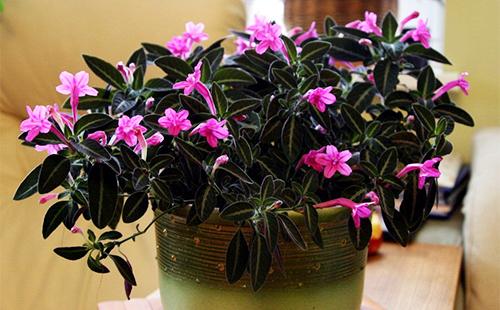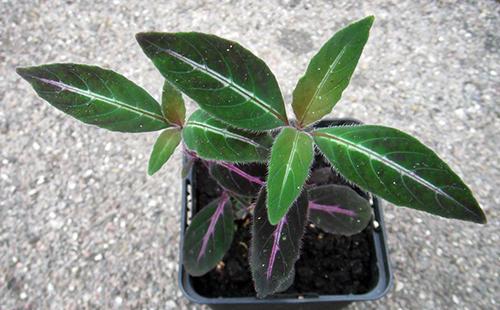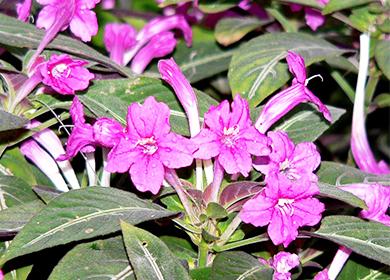The content of the article
The homeland of the flower is considered to be the subtropics of South and North America. In nature, there are about 200 varieties of this colorful flower. Moreover, not only small grassy plants, but also large shrubs that are bred in greenhouses.
Popular varieties
Florists are advised to grow four types of ruellia for growing on the windowsill.
- Devos or blue. Has a pale lilac color of flowers with brighter veins and a blue or white corolla. The velvety black-green leaves are distinguished by veins of white color and the shape of an ellipse. It grows to 40 cm in height.
- Portella. Outwardly similar to the Devil's ruellium, but differs in bright pink flowers and brownish-greenish leaves. This is the most unpretentious type of dipteracanthus.
- Large flowered. A bush with large leaves (10-14 cm long) and flowers (9 cm in diameter), which reaches a height of up to 2 m. Petals are purple, deep purple or bright pink.
- Britton. Evergreen plant up to 1 m high with wide bluish leaves and bright lilac flowers. Can be grown in colonies.
Process selection
Since the flowers of the plant fade very quickly, it is hard to buy Ruell in an ordinary flower shop. It is better to look for it with friends and in private collections.
This fragile flower is resistant to most diseases, but amenable to pests. Therefore, choosing a sprout, it is worth paying special attention to the absence of yellow spots and spiderwebs on the leaves. The faded color of the leaves can also say that the plant is unhealthy.
Actions after the purchase
The only thing worth doing on the first day is to moisten the soil with room temperature water and put the pot in a shady place (separate from other plants). Two weeks later, when the flower moves away from stress, you can transplant ruellia into another flowerpot and specially prepared soil.
Transfer
The flower has to be replanted due to the fact that it grows (stems are exposed and stretched, the decorative look is lost). To rejuvenate Roullia, they cut it, and after the top, root it at a water temperature of 20-25 ° C. Rooted cuttings are planted from a glass of water in an ordinary pot. The most favorable time for this is spring (from early March to late May).
Proper soil
Ruelia loves a mixture of humus, sand, peat, leaf and turf soil. The proportions for soil preparation are as follows:
- sand— 15%;
- turf land — 25%;
- sheet soil — 40%;
- peat— 20%.
But the flower can be transplanted into a universal substrate. It is also useful to put vermiculite as drainage.

Basic care
Most actively, the flower develops in a bright room: with insufficient lighting, the stems stretch. It is better to place the plant at the west or east window.As an option - in the back of the room on the south side, so that the delicate leaves do not twist and become covered with spots under the scorching sun.
Optimum temperature
Ruelles are good at 20-25 ° C in the summer, and 16-18 ° C in the winter. The temperature of the soil is also important, because on a cold windowsill the flower will not bloom, the growth of shoots will slow down, and the plant itself will become a paler color. To avoid this, you can water the ground with warm water. Experienced flower growers also use specialized plant lamps.
Humidity
Ruelia is afraid of excessively dry air, and during the heating season the leaves of the plant can curl and dry out. Therefore, it is desirable to provide a slightly increased room humidity. To do this, it is better to remove the flower away from batteries and heaters. Also, the plant requires regular spraying (both in summer and in winter). Another way to moisten the air near the Ruellia is to place a container of water next to it.
Irrigation intensity
Water the plant should be systematic. Little by little, every time the topsoil begins to dry out. In the cold season, watering can be reduced, but still make sure that the soil is slightly moist.
When the flower lacks moisture, the stems wither very quickly, and the ends of the leaves dry out. A long stay without water may result in the lower stems dropping completely.
Fertilizer
When transplanting ruellia into the soil, you need to add fertilizer for flowering plants. During flowering, pour mineral fertilizer twice a month. Combined fertilizers for decorative flowers are also suitable for periodic addition to the ground.
Pruning
To ensure that the ruellium does not grow as long as possible and branches well, gardeners advise periodically pruning bare stems. A plant that is less than two years old is pruned by one third of the entire length of each ugly stem. As a result, the flower will rejuvenate, be more magnificent, and new shoots will grow much faster. The tops of the stems are not thrown away, but are left in a glass of water for rooting.
Often the cause of the “baldness” of the shoots is an insufficient amount of light in the room (the plant simply stretches). In this case, it is also worth trimming a little ruellia.
Breeding
There are three ways to propagate this plant.
- Layering. To get layering, you need to tilt the shoots as close to the ground as possible so that the shoot nodes touch the soil. After the appearance of the roots, layering is carefully cut.
- Cuttings. It is necessary that the shoots are not stiff. The lower leaves are torn off from them, three or four pieces are dripped (must be watered after planting) and covered with a glass jar or polyethylene for two to three weeks. Then they begin to gradually air the plant, the room temperature should be at least 21 ° C. Cropped cuttings can also be placed for rooting in water.
- The seeds. It is necessary to wait for the fruit to ripen, extract the seeds and plant them in a moist soil to a shallow depth, be sure to cover it with a film. It is important that the lighting is scattered, and the temperature is about 18-25 ° C. Six weeks after emergence, the grown seedlings must be planted in separate flowerpots, in each of two or three pieces.

Diseases and Pests
The following parasites and diseases are able to affect Ruellia:
- whitefly and aphids - there are many white or black insects that damage young stems and cover the leaves with a sticky coating;
- spider mite - appears through black spots or a thin cobweb, which leads to curling and drying of the leaves;
- powdery mildew - has the appearance of a white coating, which causes the leaves to dry;
- gray rot - manifests itself in the form of small brown spots on the flowers or fluffy plaque on the leaves and shoots, which will have to be trimmed down to healthy tissue to get rid of the fungus.
To rid a plant of pests, insecticides are needed. In addition, during the treatment period it is important to improve the conditions of its maintenance - to provide a sufficient amount of light and heat, systematize watering, and adjust the air humidity.

